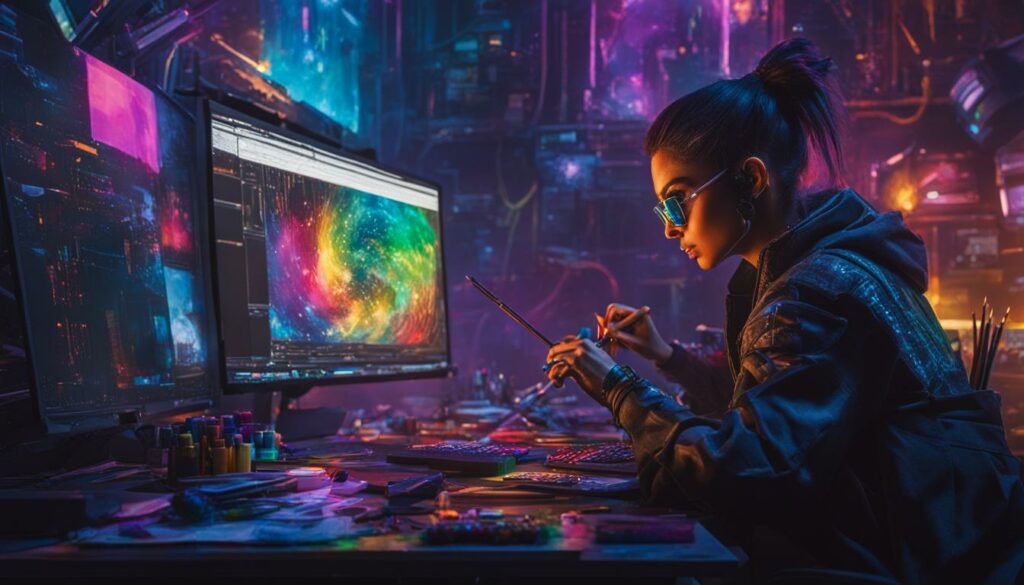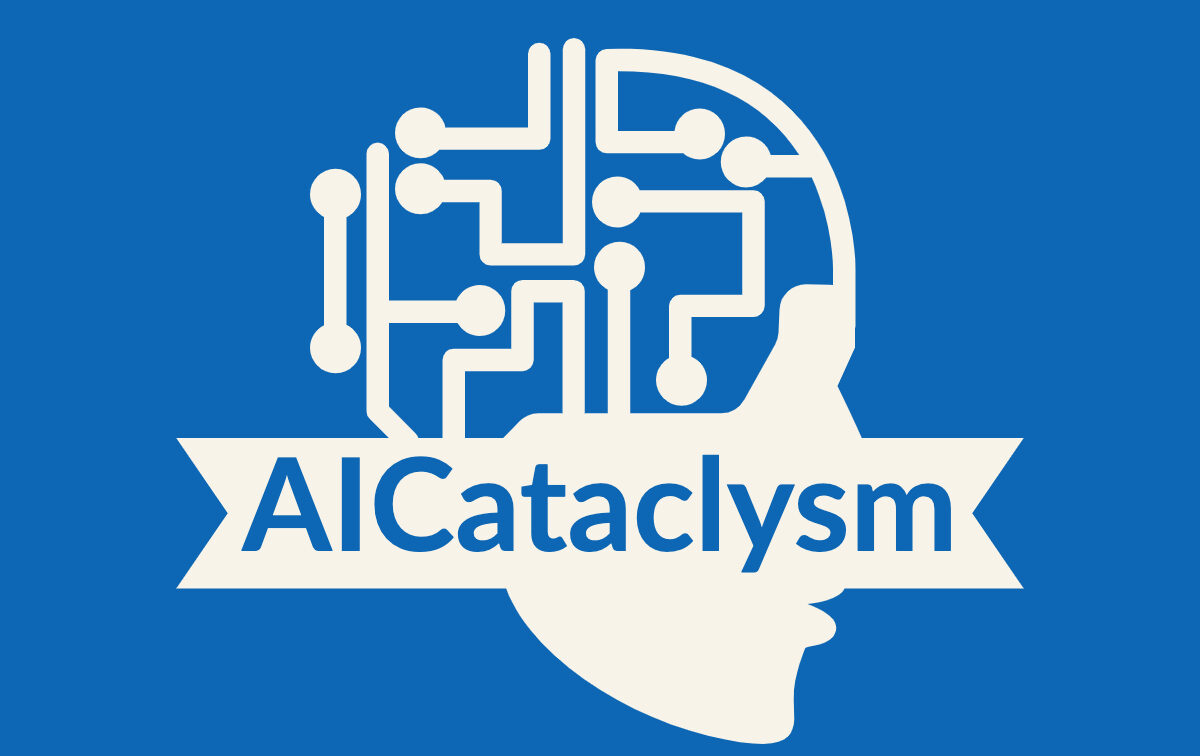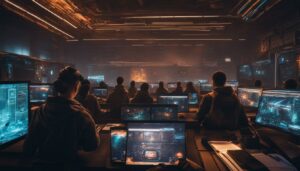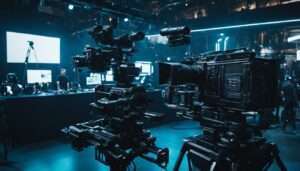Video editing has become an integral part of modern marketing, but it can be a time-consuming process. However, advancements in artificial intelligence (AI) are revolutionizing the video editing landscape, offering the potential for streamlined processes and new creative possibilities.
AI-powered tools can automate various stages of video creation, including scripting, editing, and transcription. This technology has the potential to save time, push creative boundaries, and enhance the editing process.
But what does this mean for video editors? Will AI replace them entirely? In this article, we will explore the impact of AI on video editing, the advancements in AI technology, and the future of video editing with AI-powered tools.
Key Takeaways:
- AI-powered tools offer automation and efficiency in video editing processes.
- AI can enhance creative possibilities and push the boundaries of video editing.
- While AI has its limitations, it is meant to assist and enhance the work of video editors, not replace them.
- Human creativity and expertise remain crucial in video editing, as AI cannot fully replicate it.
- The future of video editing lies in the integration of AI and human creativity, leveraging automation for optimal results.
How AI is Changing Video Marketing
Artificial intelligence (AI) is revolutionizing the world of video marketing, bringing new possibilities and efficiencies to the creative process. With AI-powered tools, video creation no longer requires a script or a camera. Generative AI algorithms can analyze existing content and generate original video content, automating tasks such as scripting, editing, and transcription. This technology saves time and expands creative possibilities for video marketers, enabling them to explore new ideas and visuals.
AI-powered tools like ChatGPT and Synthesia have already been used successfully in creating videos that are mostly or entirely powered by AI. These tools leverage AI algorithms to generate prompts and scripts, providing video marketers with starting points and options for their content. By automating tedious tasks, AI enables video marketers to focus on the cognitive, logical, and creative aspects of their work, delivering high-quality videos more efficiently. The impact of AI on video editing is significant, allowing for streamlined processes and enhanced results.
AI is shaping the future of video marketing by offering video creators the ability to automate various stages of video creation. With AI-powered tools, video marketers can generate ideas, write scripts, and automate tasks like removing objects from the background, transcribing raw footage, and enhancing audio quality. However, it’s important to note that AI is not meant to replace human editors but to assist and enhance their work. AI should be seen as a handy sidekick that streamlines the video production process, allowing video creators to focus on their creative expertise and deliver compelling content.
While AI brings tremendous benefits to video marketing, it also has its limitations. AI-generated human avatars, for example, cannot fully replicate the look and emotions of real humans. The creative decisions and personal touch that human editors bring is something that AI cannot fully replicate. It’s essential for video creators to understand when and how to leverage AI technology effectively, complementing their own creativity and decision-making with the power of AI tools. By embracing AI as a valuable tool, video marketers can stay ahead of the curve and deliver high-quality videos that captivate their audiences.
How AI Can Power Your Next Video
Artificial intelligence (AI) has the potential to revolutionize video editing by automating various tasks and streamlining the production process. AI-powered tools can assist video marketers in ideation, scriptwriting, and editing, saving valuable time and enhancing the overall quality of the videos. For example, AI tools like ChatGPT can generate prompts and options, helping video marketers come up with great ideas and compelling scripts quickly.
During the video editing stage, AI tools like Runway Al and Descript can automate tasks such as removing objects from the background, transcribing raw footage into text, and enhancing audio quality. These AI-powered tools not only save time but also improve the efficiency and effectiveness of video editing. By leveraging AI technology, video creators can focus on the cognitive, logical, and creative aspects of their work, ultimately delivering high-quality videos.
AI can act as a valuable sidekick to video creators, assisting them in automating tedious tasks and offering new possibilities for creative expression. It should be seen as a tool that complements and empowers video editors, enhancing their capabilities rather than replacing them.
The potential of AI in video editing is vast. With continued advancements in AI and video editing technology, we can expect even more innovative tools and features to emerge. AI will continue to augment video creation, empowering video marketers to push the boundaries of creativity and deliver engaging content to their audiences.
Table: AI-Powered Video Editing Tools
| Tool | Functionality |
|---|---|
| ChatGPT | Generates prompts and options for ideation and scriptwriting |
| Runway Al | Automates tasks like removing objects from the background |
| Descript | Transcribes raw footage into text and enhances audio quality |
The Limitations of AI in Video Production
While AI offers significant benefits in video production, it is important to recognize its limitations. AI-powered tools have made remarkable advancements in automating various aspects of video editing, but they are not flawless substitutes for human editors. One of the limitations is the inability of AI-generated human avatars to fully replicate the look and emotions of real humans. AI-generated content can sometimes lack the creative touch and personal perspective that human editors bring to the table.
As video creators, it is crucial to understand when and how to use AI technology effectively. While AI can automate tedious tasks and streamline the video production process, it should not replace the creative decision-making and personal touch of a human editor. Instead, AI should be seen as a powerful tool that complements and empowers video creators, enhancing their work and saving time.
To illustrate the limitations of AI in video production, let’s consider a scenario where emotion and authenticity are essential. Imagine a heartwarming video that captures the genuine emotions of a family reunion. While AI can assist in editing the footage and applying visual effects, it cannot replicate the genuine expressions and tears of joy that touch the viewers’ hearts. In such cases, the expertise and intuition of a human editor are invaluable in capturing and enhancing the emotional impact of the video.
In summary, while AI has its place in video production, it is important to understand its limitations. By acknowledging the unique skills and perspectives that human editors bring to the creative process, video creators can leverage AI as a powerful sidekick rather than viewing it as a rival. The collaboration of AI and human creativity will shape the future of video editing, allowing for innovation, efficiency, and powerful storytelling.
The Power of Human Creativity in Video Editing
While AI has made significant advancements in video editing, human creativity remains an essential aspect of the craft. AI-powered tools can automate certain tasks and enhance efficiency, but they cannot fully replicate the nuanced decision-making and artistic intuition that human editors bring to the table.
Great video editors understand the intricacies of beats, pacing, camera movements, and the impact of music on a scene. These creative decisions are rooted in their expertise and personal perspective, making each video unique and compelling. While AI-generated content can be impressive, it can sometimes lack the creative touch and emotional depth that a human editor infuses into their work.
As video creators, we have the opportunity to showcase our creativity and stand out from the crowd by adding our unique perspective to AI-generated content. By leveraging AI as a tool rather than a replacement, we can combine the efficiency of automation with our creative sensibilities to deliver high-quality videos that resonate with audiences.
Emphasizing the Human Touch
Video editing is not solely about technical prowess; it involves storytelling, emotion, and connecting with viewers on a deeper level. AI can assist with certain tasks, such as removing objects from the background or enhancing audio quality, but it cannot replicate the instinctive understanding of how to evoke specific emotions through visual and auditory elements.
By embracing our role as creative thinkers and storytellers, we can leverage AI tools to streamline our workflow and focus on the aspects of editing that require our unique human touch. We can employ AI to automate repetitive and time-consuming tasks, freeing up more time for the creative decisions that truly shape the narrative and impact of a video.
I believe that AI is a powerful tool that empowers video editors, but it should never replace them. The future of video editing lies in the symbiotic relationship between AI algorithms and human creativity, where we work hand in hand to push the boundaries of what’s possible. – [Your Name], Video Editor
The Future of Video Editing
Looking ahead, the future of video editing will involve further integration of AI technologies and human creativity. AI-powered tools will continue to advance and become more sophisticated, providing even more options and possibilities for video creators. However, it is important for us to maintain our creative vision and intuitive decision-making, as that is what sets us apart and allows us to connect with viewers on a deeper level.
As AI and video editing technologies evolve, video creators who embrace these advancements while retaining their artistic sensibilities will have a competitive edge. By striking a balance between automation and creativity, we can harness the power of AI as a valuable tool to enhance our editing capabilities and deliver impactful videos that resonate with audiences.

AI as a Handy Sidekick, Not a Rival
Artificial Intelligence (AI) has emerged as a valuable tool in video editing, revolutionizing the industry with its automation capabilities. However, it is important to recognize that AI is not meant to replace video creators but to assist and enhance their work. As a video marketer, I view AI as a handy sidekick that can streamline the video production process and automate tedious tasks.
By leveraging AI-powered video editing tools, I can focus on the cognitive, logical, and creative aspects of my work. AI can automate tasks like background removal, transcribing raw footage, and enhancing audio quality, allowing me to allocate more time to understanding clients, developing strategies, and executing projects optimally. This partnership between human editors and AI technology ensures that videos are created efficiently without compromising on quality.
When embracing AI as a sidekick, I can tap into its potential to enhance my video editing capabilities. AI-powered tools can analyze data, identify patterns, and provide valuable insights that can inform my creative decisions. Additionally, AI can speed up the editing process by suggesting alternative shots or visual effects, opening doors to new creative possibilities. With AI by my side, I can deliver high-quality videos that captivate audiences and achieve the desired marketing objectives.
Benefits of AI as a Sidekick
- Streamline video production process
- Automate tedious tasks
- Save time for creative decision-making
- Enhance video editing capabilities
- Unlock new creative possibilities
It is important to note that while AI can automate certain aspects of video editing, it cannot fully replicate human creativity. Great editors possess a deep understanding of beats, pacing, camera movements, and the impact of music on a scene. They bring a unique perspective and personal touch to their work, which cannot be replicated by AI. Therefore, video creators should embrace AI as a complementary tool rather than a rival or replacement.
The Future of Video Creation with AI
Artificial intelligence (AI) is set to transform the future of video creation, revolutionizing the way videos are produced and edited. While some may speculate whether AI will completely replace video editors, industry experts like Chris Lavigne believe that AI will enhance and complement human creativity rather than replace it. By leveraging AI-powered tools and advancements in video editing technology, video creators can take their editing capabilities to new heights, delivering high-quality videos that captivate audiences.
AI advancements in video editing have already paved the way for automation and efficiency in various stages of video production. From assisting in ideation and scriptwriting to automating tasks like object removal and audio enhancement, AI-powered tools like ChatGPT, Runway Al, and Descript streamline the editing process, saving time and effort. This integration of AI and human creativity allows video editors to focus on the cognitive and creative aspects of their work while leveraging AI’s capabilities to achieve optimal results.
While AI brings immense potential, it is important to recognize its limitations. AI-generated human avatars, for instance, may not fully replicate the authentic emotions and nuances of real humans. Human editors possess a unique understanding of beats, pacing, camera movements, and the impact of music on a scene, infusing videos with a creative touch that AI-generated content may lack. Therefore, video creators should view AI as a handy sidekick that enhances their work rather than a rival or replacement.
The future of video creation lies in striking a balance between AI and human creativity. As emerging technologies like VR, AR, real-time collaboration, and blockchain continue to shape the video editing landscape, video creators should embrace these advancements and adapt their skills to leverage the full potential of AI. By combining the power of AI with human ingenuity, video creators can unlock new possibilities and deliver captivating videos that resonate with audiences.
Emerging Technologies and Trends in Video Editing
As the future of video editing unfolds, emerging technologies and trends are poised to revolutionize the industry even further. One of the most significant advancements is the integration of artificial intelligence (AI) into video editing technology. AI-powered tools are enabling automation and enhancing the creative possibilities of video editing processes. From scriptwriting to enhancing audio quality, AI is streamlining the production process and empowering video creators.
Another emerging technology in video editing is virtual reality (VR) and augmented reality (AR). These immersive technologies offer new ways for viewers to engage with video content, creating interactive and memorable experiences. VR and AR can be used to enhance storytelling, provide 360-degree perspectives, and allow users to interact with the video elements.
Real-time collaboration and cloud-based editing platforms are also transforming the way video editing is done. These technologies enable remote collaboration, allowing video creators to work together seamlessly regardless of their locations. Instant access to assets and real-time feedback streamline the editing process and improve efficiency.
| Emerging Technologies and Trends in Video Editing |
|---|
| Artificial Intelligence (AI) in video editing |
| Virtual Reality (VR) and Augmented Reality (AR) in video editing |
| Real-time collaboration and cloud-based editing platforms |
Blockchain technology is also making its way into the video editing landscape, particularly in the realm of copyright protection and licensing. By utilizing blockchain, creators can ensure the integrity and ownership of their work, creating a more transparent and secure environment.
As these emerging technologies and trends continue to shape the field of video editing, video creators need to stay informed and adapt their skills accordingly. Embracing these technologies can unlock new possibilities and enhance the overall quality of video production.
Challenges and Considerations in the Future of Video Editing
As video editing evolves with the integration of artificial intelligence (AI), there are important challenges and considerations that video editors must navigate. One of the key challenges is ensuring ethical use of AI in video editing processes. It is crucial to align AI-driven editing with ethical guidelines to avoid biased content creation and promote fairness and inclusivity.
Another consideration for video editors is the constant need to adapt their skills to new tools and technologies. As AI-powered editing tools become more prevalent, video editors must stay updated and acquire the necessary knowledge to effectively utilize these tools. By embracing new technologies and expanding their skill sets, video editors can thrive in the future of video editing.
Data privacy and security also pose challenges in the AI-driven video editing landscape. With increasing reliance on data-driven editing, video editors must prioritize protecting user data and ensuring compliance with privacy regulations. Implementing robust data protection measures is essential to maintain trust and safeguard sensitive information.
While AI can automate certain aspects of video editing, striking a balance between automation and creative decision-making is crucial. Video editors should be mindful of maintaining the human touch and creative perspective in their work. By leveraging AI tools as assistants, video editors can enhance their creative process and deliver high-quality videos that captivate audiences.
FAQ
Will AI replace video editors?
No, AI is not meant to replace video creators but to assist and enhance their work. Video marketers should view AI as a handy sidekick that can automate tedious tasks and streamline the video production process.
How is AI changing video marketing?
AI is revolutionizing video marketing by enabling video creation without the need for writing a script or picking up a camera. It can automate various stages of video creation, saving time and expanding creative possibilities.
How can AI power my next video?
AI can assist in ideation and scriptwriting, helping video marketers come up with great ideas and compelling scripts quickly. AI tools can also automate tasks like removing objects from the background, transcribing raw footage, and enhancing audio quality.
What are the limitations of AI in video production?
AI-generated human avatars do not fully replicate the look and emotions of real humans. AI is not a perfect substitute for shooting real human beings and capturing their authentic emotions.
What is the power of human creativity in video editing?
While AI can automate certain aspects of video editing, it cannot fully replicate human creativity. Great editors understand beats, pacing, camera movements, and the impact of music on a scene. They bring a creative touch and personal perspective that AI-generated content can sometimes lack.
Is AI a rival to video creators?
No, AI should be seen as a tool that complements and empowers video creators, rather than as a rival or replacement. It can automate tasks and save time, allowing video creators to focus on the cognitive, logical, and creative aspects of their work.
What is the future of video creation with AI?
The future of video editing will involve the integration of AI and human creativity, with AI-powered tools assisting in various stages of video creation. Video marketers who embrace AI will leverage automation and AI’s capabilities to enhance their editing capabilities and deliver high-quality videos.
What are the emerging technologies and trends in video editing?
Emerging technologies like AI, machine learning, virtual reality, augmented reality, real-time collaboration, cloud-based editing platforms, and blockchain are transforming the video editing landscape and offering new opportunities for video creators.
What are the challenges and considerations in the future of video editing?
Ethical use of AI, skill adaptation, data privacy, and striking a balance between automation and creativity are some of the key challenges that video editors may face in the future. Ensuring AI-driven editing aligns with ethical guidelines and maintaining the human touch in video editing are crucial.






